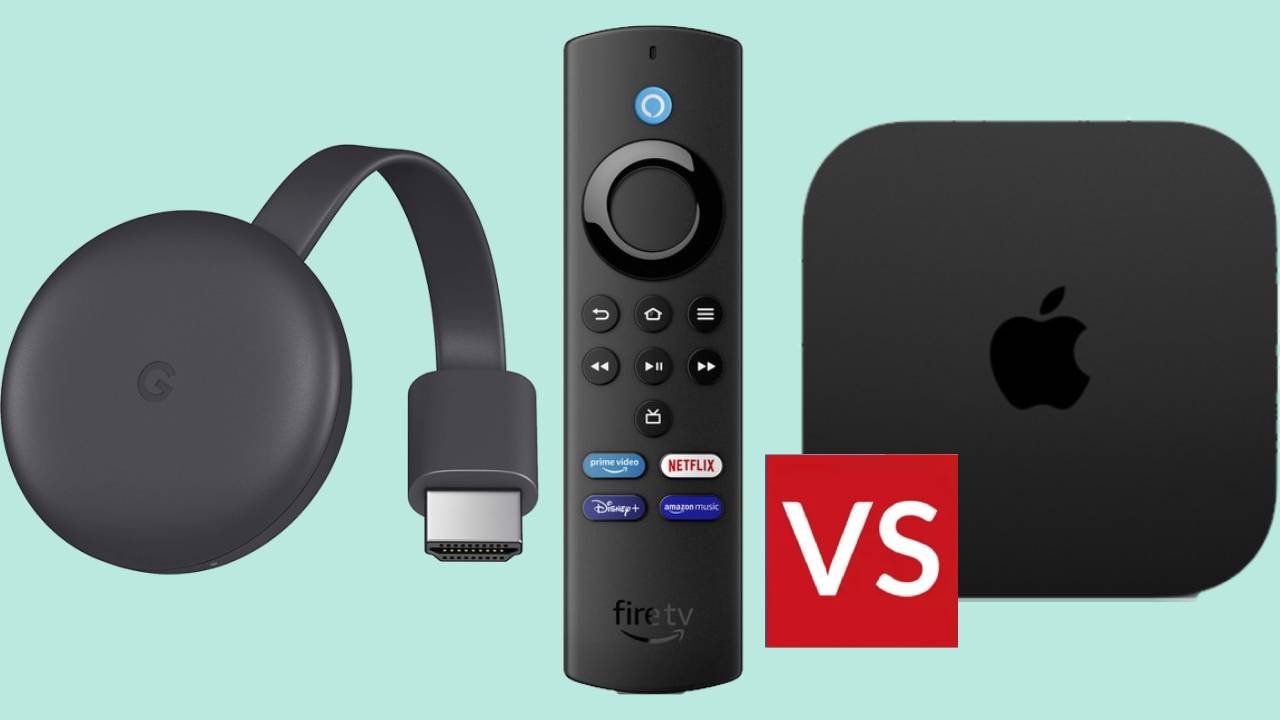Chromecast vs Fire TV Stick vs Apple TV 4K: which streaming device should you pick?
Here’s how to decide which streaming system is best for you


Cord-cutting has been a trend among TV audiences for years now. And now with inflation driving prices up right across our monthly budgets, this could be the perfect time to reconsider your traditional satellite TV subscription, and instead move exclusively to streaming.
Google, Amazon and Apple offer three of the most popular streaming devices, and while others also exist, it's this trio that offers the most content, the best features and the slickest user experience.
They also all offer a range of devices, which all look and work in a similar way, but vary in terms of features, performance and of course price. Picking the right one depends on your needs and also what type of television they’ll be connected to.
Chromecast vs Fire TV Stick vs Apple TV 4K: Hardware and design

All three work in a very similar way. The Amazon Fire TV and Chromecast with Google TV are dongles that plug into an HDMI port on the back of your TV, and just hang there. Out of sight, they don’t need to sit on a shelf or take up any space in front of the television.
Apple’s TV 4K takes a different approach and looks more like a traditional set-top box, with its HDMI cable and needing to sit somewhere. That said, you could just hide it behind the TV or inside your media cabinet, as it doesn’t need line-of-sight with the included remote.
Speaking of which, all three streamers come with a simple remote for browsing through streaming services and controlling content. In many cases they can control the power and volume of your TV or sound system too, so can act as your one-and-only remote.
Amazon sells a broad range of Fire TV products, all with a remote that can summon the Alexa voice assistant at the press of a button. The cheapest is called Stick Lite, costs £35 and streams content at Full HD resolution, also known as 1080p. The regular Fire TV Stick comes next, costing £45 and having a remote with TV volume controls.
Get all the latest news, reviews, deals and buying guides on gorgeous tech, home and active products from the T3 experts
Above this sits the Fire TV Stick 4K, which streams content in 4K resolution with support for Dolby Vision, Dolby Atmos and HDR. Lastly, the Fire TV Stick 4K Max has improved Wi-Fi, more RAM, a more powerful processor and live view picture-in-picture.
The Chromecast with Google TV range is simpler. There’s a Full HD version that comes in white (with matching remote) for £34.99 and a 4K version with three colour options for £59.99.
Lastly, the Apple TV 4K is the most expensive of the three streamers. It starts at £149 for a model with 64GB of storage (plus support for Dolby Vision, Dolby Atmos and HDR10+), then extends to £169 for a version with 128GB of storage and an Ethernet port. The latter is handy if you want a wired connection to your router, as perhaps you live in a home with thick walls and flakey Wi-Fi.
Chromecast vs Fire TV Stick vs Apple TV 4K: Software and content

All three streamers work in a very similar way. They all have access to the most popular catchup services, like BBC iPlayer ITV X and Channel 4, plus YouTube and subscriptions like Netflix, Disney+, Amazon Prime Video, Now TV and Apple TV+.
Although it hasn’t always been the case, it’s not easy to watch a rival service – for example, you can watch Amazon’s Prime Video on an Apple TV 4K, and you can watch Apple TV+ on a Fire TV Stick, or a Chromecast with Google TV. You can also access music streaming services, like Spotify or Apple Music, and view your image libraries on the TV, and the Apple TV 4K has access to Apple’s Fitness+ subscription service, streaming pre-recorded exercise classes to your television.
All three streamers include access to their manufacturers’ respective voice assistants, in the form of Google Assistant, Alexa and Siri. which can be used to find and control content.
Chromecast vs Fire TV Stick vs Apple TV 4K: Connectivity and smart home features

There’s much more to streaming devices than bingeing your latest Netflix addiction. They can all connect to smart speakers for improved audio, for a start. Google’s Chromecast hooks up to the company’s Nest Audio, while Amazon Fire Sticks can use a range of different Echo speakers to create a stereo or full surround sound system. The Apple TV 4K can also do this with the company’s HomePod and HomePod mini smart speakers.
Streaming devices can connect to smart home products too. They can each display live video feeds from smart security cameras and compatible video doorbells, and you can ask their integrated voice assistants to adjust smart lighting, change the temperature of a smart thermostat, turn on smart plugs and so much more.
Other tricks include the Apple TV 4K’s ability to calibrate its picture output using the camera of your iPhone, and how games are available on all three streaming devices.
Chromecast vs Fire TV Stick vs Apple TV 4K: Which is best for you?
Since all three can access all of the most popular streaming services, deciding which to buy comes down to personal preference and which ecosystem you’re already a part of. Own a couple of Nest speakers? Then the Chromecast will be best for you. Already pay for Amazon Prime and have a Ring Video Doorbell? You should check out the Fire Stick TV range. Card-carrying member of Club Apple? The Apple TV 4K is the priciest of the bunch, but it’ll slot neatly into your current tech ecosystem.
If you're coming into this fresh, with no smart home devices or an open mind as to which is best, then it comes down to budget. For us, we think the 4K version of the Chromecast with Google TV represents great value for money, as we reckon Google Assistant has a slight edge over Alexa when it comes to intelligence.
That said, if you’re shopping for a streaming device for a smaller TV, perhaps in the kitchen or bedroom, it’s hard to say no to the regular HD version of Chromecast, or the equally priced £35 Amazon Fire TV Stick Lite.
Alistair is a freelance automotive and technology journalist. He has bylines on esteemed sites such as the BBC, Forbes, TechRadar, and of best of all, T3, where he covers topics ranging from classic cars and men's lifestyle, to smart home technology, phones, electric cars, autonomy, Swiss watches, and much more besides. He is an experienced journalist, writing news, features, interviews and product reviews. If that didn't make him busy enough, he is also the co-host of the AutoChat podcast.
